Biblical Archaeology
| Student files |

Biblical archaeology is an important apologetics discipline that substantiates the Bible as a valid historical document, and the Biblical chronology as accurate timeline. Each year new discoveries are made, and creationists are encouraged to keep themselves informed of progress in this field. The study of Biblical Archaeology is also an important aid to the correct understanding of the Bible, since it gives a description of the lands of the Bible and of social customs, civil and religious, of the biblical characters.[1] At least 50 major figures from the Old Testament have been confirmed from archaeology.[2]
Discoveries
Dead Sea Scrolls
- Main Article: Dead Sea Scrolls
The finding of the Dead Sea Scrolls is considered by many to be the most important archaeological find of the last century. Besides confirming the reliability of the Old Testament and its prophecies as untainted by later church leaders, they have also allowed us a glimpse into the era Jesus was born into, and the society that existed at the beginnings of Christianity.
Temple of Jerusalem
- Main Article: Temple of Jerusalem
Not until the time of King Solomon did God permit the construction of a permanent building to be his temple. The first temple was built in Jerusalem in the 10th or 11th century BC by King Solomon. The site was the one purchased for the purpose by King David, the threshing floor of Araunah the Jebusite, on which he built an altar to the Lord. King David’s Altar, Solomon’s Temple, and Herod’s Temple all stood in the same location.
Jericho
- Main Article: Jericho
In the 1950's, archaeologist Kathleen Kenyon supervised the excavation of the ruins of the once great city. Her lack of faith in the Biblical account of Jericho was evident in her statement that she believed the 'folk tale' of Joshua's encounter with the city was merely fabricated after the destruction. However, later digs have prompted other archaeologists to come to a bold conclusion: the walls really did fall as told in Joshua 6 .
James Ossuary
- Main Article: James Ossuary
A 2,000-year-old box was discovered in October of 2002 that might be the ossuary (“Bone Box”) of James, the brother of Jesus. On the side of the bone box is inscribed in Aramaic: “Ya'akov bar Yosef akhui di Yeshua”, which is translated “James, son of Joseph, brother of Jesus”. As the inscription was the first historic record found of Jesus apart from manuscripts, its authentication could prove to be the most significant New Testament find in modern times.
Synagogue and House of Peter
- Main Article: Capernaum
Capernaum was a village inhabited from approximately 150 BC to 1100 AD. The ancient ruins of Capernaum have been thoroughly investigated by archaeologists revealing, most notably, an ancient Jewish synagogue and Christian church located at the site of the house of Simon Peter. Although tradition held that the ruins of Capernaum were there on the northwestern shore of the Sea of Galilee, it wasn't until 1838 that remains of a synagogue were correctly identified.
King David's Palace
Archaeologist Eilat Mazar has found strong evidence that the foundations of a structure in old Jerusalem, confirmed to date to the 10th-9th centuries B.C., are very likely the remains of the palace of King David. Furthermore, the remains match perfectly with the geographic and architectural description of the palace given in the Bible.[3]
Tell Dan
The ancient city of Israel contains the world's oldest known gated archway and is known today as Tell el-Qadi. An inscription found on site reads "To the God who is in Dan, Zoilos made a vow." Identified in 1838, the best-known excavations began in 1966, continuing to the present day. The Tell Dan Stele was discovered here, along with an elaborate gate, a pottery shard with the name Zechariah on it, and a series of huge defensive ramparts. Settlement appears to have begun as early as 4500 B.C.[4]
Evidence for the Exodus
The earliest mention of the Biblical God, Yahweh, has been discovered from two Egyptian descriptions, with the oldest, the Soleb Inscription, dating to 1400 B.C. In mentioning a list of lands campaigned against by Egypt, the Soleb Inscription refers to the "land of the Shasu of Yahweh" so it is clear Israel had become a nation by that time. This provides strong evidence that the Israelite Exodus had completed by 1400 B.C.[5] The Ipuwer Papyrus provides evidence of the Biblical plagues. The ancient Egyptian document records events similar to the plagues of the Exodus.[6]
The distinctive 4-room Israelite house has been discovered in Tell el-Daba, Egypt dating back to 1175 A.D.[7] What is more, found among these distinctive Israelite houses was one which may have been Joseph's containing a tomb that very unusually had the skeleton removed consistent with Exodus 13:19 and Genesis 50:25.[8]
| “ | One of the tombs
was monumental in construction and totally unique in finds.
Inside were found stone fragments of a colossal statue of a
man who was clearly Asiatic, based on the yellow painted
skin, the red-painted mushroom-shaped hairstyle and a
throwstick on his right shoulder (the hieroglyph for
foreigner). The statue had been intentionally broken in
antiquity. While the other tombs nearby had intact
skeletons, the only finds in the monumental tomb were
fragments of an inscribed limestone sarcophagus and a few
bone fragments. The body was gone! While it was common to
plunder tombs in ancient Egypt, the bodies were usually not
taken. Could this be the tomb of Joseph, from which he
commanded his bones to be carried back to Canaan (Gn 50:25;
Ex 13:19)? ~ Gary Byers, Associates for Biblical Research[9] |
” |
A 3rd century B.C. Egyptian historian named Manetho wrote that the Hyksos founded their capital at Avaris, also known as Tell el-Daba, where the Israelite houses were found. As noted by Noah Wiener of the Biblical Archaeological Society, "After the Hyksos were expelled from Egypt, Manetho reports that they wandered the desert before establishing the city of Jerusalem... The Egyptian Queen Hatshepsut (1489–1469 B.C.E.) recorded the banishment of a group of Asiatics from Avaris, the former Hyksos capital."[10]
Furthermore, the Amarna Tablets record the Israelite takeover of Canaan. Letters such as those by Abdu-Heba and Rib-Addi show Canaanite kings pleading with Egypt to send them military aid to stop the Israelites from conquering the land.[11] Dating to the 14th century B.C., they provide strong evidence for an early date to the Exodus.
Those claiming the Exodus lacks graves evidencing the Exodus are not finding the graves because they are looking on the wrong peninsula, the Sinai Peninsula. The Exodus occurred across Saudi Arabia/the Arabian Peninsula, which does have thousands, possibly millions, of ancient graves supporting the Biblical Exodus.[12]
For the location of the Biblical Mount Sinai, see Jebel al-Madhbah. The Bible makes plain the Mount Sinai is in Seir or Edom. (Deuteronomy 33:2, Judges 5:4-5) As an interesting note, Edom or Esau literally means "red" and Jebel al-Madhbah is in Petra, a city that is one of the 7 wonders of the world, renowned for its blood-red stone and architecture.
Other Artifacts
| Name | Image | Date | Institution | Description |
|---|---|---|---|---|
| Tower/Walls of Jericho[13] |
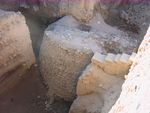 |
8,000 B.C.? | Tell es-Sultan | Walls destroyed around 1,400 B.C. by an earthquake and a city destroyed by fire matching the Bible perfectly. A preserved tower connected to the destroyed walls has been dated at 8,000 B.C. |
| Ebla Tablets[14] | 150px | 2500-2250 B.C. | Syrian Museums | 17,000 tablet library confirming names of Biblical cities (e.g. Jerusalem, Ashdod, Sidon, Carchemish), individuals (e.g. Adam, Michael, Esau), and early ritual sacrifice. The tablets provide evidence defeating the claims of Biblical critics such as a complex legal code and mention of both Canaan and the Hittites; critics claimed all were later revisions. The alphabet is strikingly similar to Hebrew. There is also a creation account similar to that of Genesis. |
| Code of Ur-Nammu[15] |
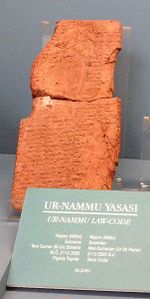 |
2100-2050 B.C. | Iraq National Museum | Ancient law code of Mesopotamia similar to the Laws of Eshnunna and Code of Hammurabi, it helped disprove the claims of critics who'd accused the Mosaic Law of being fictional, saying such a complex law could not have existed so long ago. Several laws are strikingly similar to the Mosaic Law, it may be that the Mosaic Law was actually based on similar ancient laws of Mesopotamia (where Abraham once lived). For detail on Moses' creation of the Law, see Exodus 18:13-27, John 1:17, and Matthew 19:7-9. |
| Laws of Eshnunna[16] |
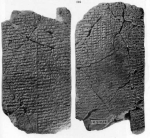 |
1930 B.C. | Iraq National Museum | Ancient law similar to the Mosaic Law like the better-known Code of Hammurabi and Code of Ur-Nammu. |
| Execration Texts[17] |
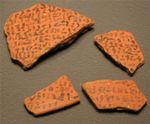 |
1878-1630 B.C. | Inscribed Egyptian bowls and figurines with early mention of Biblical locations and names such as Jerusalem, Abraham, Canaan, Job, Shechem, Hazor, Tyre, etc. | |
| Code of Hammurabi[18] |
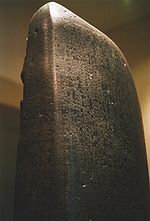 |
1790 B.C. | The Louvre | Ancient law with rules identical in numerous places to the Bible's Mosaic Law, silencing an early criticism by liberal scholars that a law as complex as the Mosaic could not have existed so early. |
| Atra-Hasis Tablets[19] |
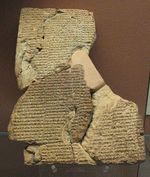 |
1650 B.C. | British Museum | Ancient Babylonian account with detail similar to the Garden of Eden and Noahic Flood, part of the Epic of Gilgamesh. |
| Soleb Inscription[20] | 150px | 1400 B.C. | The earliest reference to the Biblical God Yahweh, the inscription refers to the "land of the Shasu of Yahweh." It has been discovered in two Egyptian locations, the temple of Soleb built by Pharaoh Amenhotep III (1400 B.C.) and Amarah-West built by Rameses II (1250 B.C.), both of which are in modern-day Sudan. As such, this is a powerful evidence that the Israelites were in Canaan by 1400 B.C. in support of an early date for the Biblical Exodus.[5] | |
| Amarna Tablets[21] |
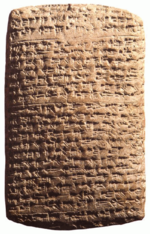 |
1370-1350 B.C. | British Museum, Vorderasiatisches Museum, Cairo Museum, et. al. | Letters between Egyptian pharaohs and Canaanite kings mentioning the takeover of Canaan by the Apiru/Hebrews and disproving an early criticism of the Bible that the Canaanites were not as advanced as the Bible claimed. |
| Ipuwer Papyrus[22] | 150px | 1275 B.C. | Dutch National Museum of Antiquities | Egyptian account mentioning the plagues of Egypt (e.g. rivers turning to blood, death of firstborn children, plagues of hail/fire/darkness, etc.) and the exodus of Jews from Egypt. |
| Ugarit Cuneiform Tablets[23] | 150px | 1250 B.C. | Institute for Antiquity and Christianity | Ancient texts similar to the Bible suggesting Abraham did live in Canaan (Genesis 11:31) and verifying numerous Biblical details about ancient Canaan such as its prevalence of animal sacrifice. |
| Merneptah Stele[24] |
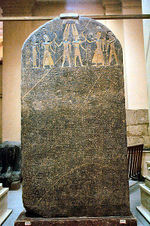 |
1209 B.C. | Cairo Museum | Long regarded as the earliest recorded explicit mention of Israel, the stele mentions Egypt's attack on Israel as part of a campaign in Canaan, and appears related to the Amarna Tablets. When discovered it refuted the claim that Israel had not existed so early. |
| Tell es-Safi Potsherd[25] | 150px | 1075-925 B.C. | Bar Ilan University | Proved the name Goliath (1 Samuel 17:4-10) was used in Israel close to the time the Bible said Goliath existed, with the possible hometown of Goliath (Gath) now excavated at Tell Es-Safi. |
| Ophel Inscription[26] | 150px | 1000-900 B.C. | Discovered by Eilat Mazar at the palace of David, it contains the earliest undisputed use of the Hebrew alphabet in Jerusalem. It provides another powerful evidence against the criticism of Biblical minimalists that insinuate Israel was not the powerful kingdom under David and Solomon that the Bible claims. | |
| Bubastite Portal[27] |
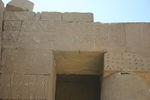 |
945-924 B.C. | Karnak, Egypt | Verifies the campaign of Shishaq I against Israel described in 1 Kings 14:25-28 and 2 Chronicles 12:2-12, as well as Biblical cities such as Megiddo and Ajalon. |
| Gezer Almanac[28] |
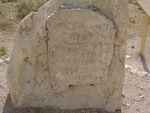 |
925 B.C. | Istanbul Archaeological Museums | Early example of Israelite writing, an agricultural calendar. |
| Tel Dan Stele[29] |
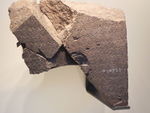 |
870-750 B.C. | Israel Museum | Refers to an Aramean king's victory over Israel and the "House of David," thus disproving critics who had claimed King David was a literary invention. Many Biblical scholars believe the stele mentions the defeat of King Jehoram of Israel and King Ahaziah of Judah by Hazael of Damascus as mentioned in 2 Kings 8-9. |
| Black Obelisk of Shalmaneser III[30] |
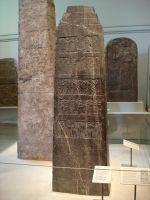 |
858-824 B.C. | British Museum | Contains the earliest undisputed image of an Israelite, Omri, son of Jehu, a king of Israel. (1 Kings 16:16-28) |
| Kurkh Stele[31][32] |
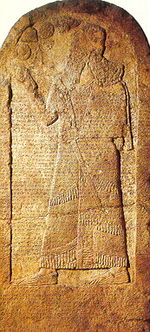 |
852 B.C. | British Museum | An early reference to the nation of Israel and King Ahab, as well as mention of his army (2,000 chariots 10,000 foot soldiers), which contradicts the claims of Biblical minimalists/critics who assert Israel had no such fighting force at the time. The Shalmaneser lineage is mentioned as rulers of Assyria in 2 Kings 17:3 and 18:9. |
| Mesha Stele[33] |
.jpg) |
840 B.C. | Louvre Museum | Moabite monument mentioning Yahweh, Israel and its king, Omri, David, and the kingdom of Judah. When discovered it dealt a serious blow to the claims of critics who'd said David had not existed.[34] |
| Tell al-Rimah Stele[31][35] |
 |
811-783 B.C. | Mentions King Jehoash of Israel paying tribute to Assyria. (2 Kings 12:18) | |
| Kuntillet ‘Ajrud Inscription[36] | 150px | 750 B.C. | Tel Aviv University | Verifies the name Yahweh as well as Israelite idolatry to Asherah as mentioned in Judges 6:25-30. |
| Nimrud Tablet[37] |
 |
733 B.C. | British Museum | One of the earliest references to the Kingdom of Judah, it mentions Ahaz as the ruler of Judah being forced to pay tribute to Syria's Tiglath-Pileser. It also mentions Hoshea being selected by Syria as his replacement per 2 Kings 17-18. |
| Nimrud Prism[38] | 150px | 720 B.C. | British Museum | Mentions the deportation of Israelites to Babylon captured from Samaria by King Sargon II, the Babylonian Exodus. It also confirms the specific location of Assyria that Israelites were deported to, Halah in Assyria.[39] |
| Siloam Inscription[40] | 150px | 701 B.C. | Archaeological Museum of Istanbul | Verifies the existence of Hezekiah's tunnel mentioned in 2 Kings 20:20 and 2 Chronicles 32:30. It was found in 1880 and is one of the oldest Hebrew inscriptions yet discovered. |
| Lachish Relief[41] |
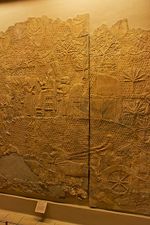 |
700-681 B.C. | British Museum | Drawings of Assyria's King Sennacherib defeating King Hezekiah of Judah and capturing numerous cities, discovered in his palace at Nineveh. Provides a visual recording of the Biblical account mentioned in 2 Chronicles 32, 2 Kings 18-19, and Isaiah 36-37. Lachish has also been excavated, providing additional evidence of the siege.[42] |
| Sennacherib's Annals[43] |
 |
690 B.C. | British Museum, Oriental Institute of Chicago, Israel Museum | Also known as the Taylor Prism, the annals were discovered in the Assyrian capital of Nineveh. They describe Assyria's King Sennacherib defeating King Hezekiah of Judah and provide evidence for the Biblical account (Chronicles, Kings, Isaiah) as well as some verification of the Angel of the Lord's destruction of Sennacherib's army per Isaiah 37:33-38.[44] |
| Flood Tablet[45] |
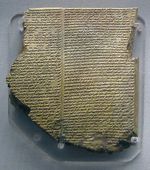 |
650 B.C. | British Museum | Ancient Babylonian account with detail similar to the Noahic Flood, part of the Epic of Gilgamesh. |
| Lachish Letters[46] |
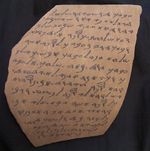 |
588 B.C. | British Museum | Letters between military officers Joash and Hoshaiah before Lachish fell to the Babylonian army during the rule of Zedekiah, King of Judah. The Old Testament name for God, YHWH, is repeatedly used, and the letters verify the Bible's account of the Babylonian attack (Jer. 34:7). Elnathan of Jer. 26:22 is also mentioned. |
| Nabonidus Cylinder[47] |
 |
555-540 B.C. | British Museum and Pergamon Museum | Clay cylinders of King Nabonidus of Babylon that mention Belshazzar and other details similar to the book of Daniel. The cylinders disprove the claims of critics who'd denied Belshazzar's historicity or that he was the child of Nabonidus and reveal the Nabonidus shared coregency with his son Belshazzar, thus explaining why Daniel could be appointed "third ruler of the kingdom." (Daniel 5:16)[48] |
| Cyrus Cylinder[49] |
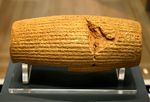 |
539-530 B.C. | British Museum | Clay cylinder by King Cyrus the Great verifying the return of exiled people from Babylon, such as the Jews after the Babylonian captivity, to their respective lands, and supporting the rebuilding of Jerusalem's temple. (e.g. Ezra 1:1) The cylinders are considered the world's first charter of human rights and are considered one of the most important artifacts in history.[50] They may also provide evidence of King Cyrus praising the God of the Bible as mentioned in 2 Chronicles 36:22-23.[51] |
| King Herod Wine Jug[52] | 150px | 19 B.C. | While excavating King Herod's palace (Fortress Masada) archaeologists in 1996 discovered a wine jug bearing Herod's full title, Herod King of Judea. Herod's mausoleum, a royal theater box,[53] and coins bearing his image[54] have since been discovered as well. | |
| Pilate Inscription[55][56] |
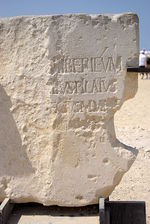 |
26-37 A.D. | Israel Museum | Contains the name Pontius Pilate, verifying his existence after minimalists claimed the Bible invented him.[57] Pilate's name has since been discovered inscribed on Roman coins as well.[58] |
| Caiaphas Ossuary[59][56] |
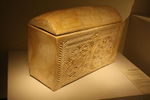 |
36-50 A.D. | Israel Museum | Burial chamber of Caiaphas, the Jewish high priest at the time of Jesus as mentioned in Matthew 26:3, John 18:13-28, and Acts 4:6. Its discovery was a major blow to Biblical critics who claimed the Gospel's accounts of Jesus were mythical. A separate ossuary of Caiaphas' daughter Miriam was authenticated in 2011.[60] |
Archaeology Sites
| Site | Country | State / Province / Region |
|---|---|---|
| Capernaum | Israel | |
| Jericho | Israel | |
| Ephesus | Turkey | |
| Megiddo | Israel | Jezreel Valley |
| Mount Ararat | Turkey | |
| Mount Sinai | Egypt | Sinai Peninsula |
| Temple of Jerusalem | Israel | |
| Qumran | Israel |
Archaeologist
An archaeologist is a person who studies the past using scientific methods with the goal of recording, interpreting, and preserving knowledge of ancient and contemporary cultures. The following is a list of archaeologists whose work has played an integral role in Biblical apologetics.
- William F. Albright
- Millar Burrows
- David Down
- John Garstang
- Sir William Ramsey
- Edwin Thiele
- Clifford Wilson
- Bryant Wood
- Ron Wyatt
Biblical Archaeology News
- Archaeologists Searching for Ark of the Covenant and Tabernacle Find Biblical Clues at Shiloh Dig Shiloh is mentioned in the Bible as the site where the the Ark and the Tabernacle, believed to be the earthly dwelling place of God, were venerated for close to 369 years. Christian Post, July 18, 2017.
- Archaeologists Discover Solomon-era Linens Archaeologists from Tel Aviv University have unearthed 3,000-year-old dyed wool fabric samples from the time of Kings David and Solomon. Christian Headlines, July 17, 2017.
- Israel to complete east Jerusalem center after controversial UNESCO vote Netanyahu announces plans in the aftermath of two votes the World Heritage Committee took last week in Krakow, Poland. Jerusalem Post, July 9, 2017.
- Uncovered in Jerusalem, 9 tiny unopened Dead Sea Scrolls Researcher finds tantalizing tefillin parchments from Second Temple era, overlooked for decades and unread for 2,000 years. The Times of Israel, March 12, 2014.
- Does a “Recently Deciphered 4,000-Year-Old Tablet” Discredit the Genesis Account of Noah's Ark? Tablet that corroborates the biblical record is used by skeptics to attack the biblical accounts. Answers in Genesis, January 27, 2014.
- Ancient tablet reveals new details about Noah's Ark prototype Author claims old clay tablet from ancient Mesopotamia was the original source of the Flood story found in the Bible. Fox News, January 24, 2014.
- New test dates Shroud of Turin to era of Christ New examination dates the shroud to between 300 BC and 400 AD, which would put it in the era of Christ. USA Today. March 30, 2013.
- Shroud of Turin to be Broadcast Live Shown on television for the first time in 40 years on Easter Saturday. Discovery News. March 30, 2013.
Biblical archaeology
Reference
- ↑ Berkhof, Louis (1928). Biblical Archaeology (3rd, revised ed.). Grand Rapids, Michigan: Smitter Book Company. p. 17.
- ↑ Mykytiuk, Lawrence (2014, March 3). 50 People in the Bible Confirmed Archaeologically. Biblical Archaeology Society.
- ↑ Mazar, Eliat. "Did I Find King David's Palace?" Biblical Archaeology Review 32:01 January/February 2006. Accessed August 24, 2008.
- ↑ Zias, Levana (2011, December). Archaeologists Excavate Legendary City of Dan. Popular Archaeology. Volume 5.
-
↑ 5.0 5.1 Aling,
Charles, & Billington, Clyde (2010, March 8). The
Name Yahweh in Egyptian Hieroglyphic Texts. Associates
for Biblical Research.
Argubright, John (2013). Bible Believer's Archaeology, Volume 3: Behold the Man! p. 108. BibleHistory.net. ISBN: 978-09792148-2-0. - ↑ Becher, Mordechai. The Ten Plagues - Live From Egypt. Ohr Somayach.
- ↑ Bietak, Manfred (2003). Israelites Found in Egypt. Biblical Archaeology Society. Retrieved July 10, 2014.
- ↑ Wood, Bryant G. (1998). Is there evidence that the Israelites once lived in Egypt as the Bible says? Has Joseph's original tomb been found? Associates for Biblical Research. Retrieved July 10, 2014.
- ↑ Byers, Gary (2008, September 24). Israel in Egypt. Associates for Biblical Research. Retrieved July 10, 2014.
- ↑ Wiener, Noah (2014, February 11). The Expulsion of the Hyksos. Biblical Archaeological Society. Retrieved July 10, 2014.
- ↑ Dollinger, Andre. The Amarna Letters. Reshafim.org.il.
- ↑ Kessler, Rebecca (2011, February 15). Thousands of Tombs in Saudi Desert Spotted From Space. LiveScience.
-
↑ Wood,
Bryant G. (2008, May 1). "Did
the Israelites Conquer Jericho? A New Look At The
Archaeological Evidence." Associates for Biblical
Research.
Permanent Delegation of Palestine to UNESCO (2012, April 2). "Ancient Jericho: Tell es-Sultan." United Nations Educational, Scientific and Cultural Organizations. -
↑ Wilson,
Clifford (1977). EBLA:
Its Impact on Biblical Records. Institute for Creation
Research.
Holden, Joseph M. & Geisler, Norman (2013). The Popular Handbook of Archaeology and the Bible. p. 86. Harvest House Publishers.
Wieland, Carl. Archaeologist Confirms Creation and the Bible. Creation Ministries International.
Sala, Harold J. (2008). Why You Can Have Confidence in the Bible: Bridging the Distance Between Your Heart and God's Word. pp. 125-127. Harvest House Publishers.
Elwell, Walter A. & Comfort, Philip W. (2001). Tyndale Bible Dictionary. p. 397. Tyndale House Publishers.
David Noel Freedman, "The Ebla Tablets and the Abraham Tradition," in Reflections on Mormonism: Judaeo-Christian Parallels, ed. Truman G. Madsen (Provo, UT: Religious Studies Center, Brigham Young University, 1978), 67–78.
Milano, Luciano. Ebla Digital Archives. Ca' Foscari University of Venice. -
↑ 8.
Law. The Schoyen Collection.
Andrews, Evan (2013, December 17). 8 Things You May Not Know About Hammurabi’s Code. The History Channel. -
↑ Eshnunna.
Encyclopaedia Britannica.
Law Code of Eshunna. Iraq National Museum. U.S. Department of State, Bureau of Educational and Cultural Affairs.
Yaron, Reuven (1988). The Laws of Eshnunna. The Magnes Press. The Hebrew University. -
↑ Sailhamer,
John H. (1998). Biblical
Archaeology. p. 45. Zondervan.
Tenney, Merrill C. (2010). The Zondervan Encyclopedia of the Bible. p. 144. Zondervan.
Laughlin, John C.H. (2000). Archaeology and the Bible. p. 60. Routledge. -
↑ Stele
with Law Code of Hammurabi . American
Historical Association.
Rummell, S. The Hammurabi Stele. Texas Wesleyan University.
Claire, Iselin. Law Code of Hammurabi, king of Babylon. Louvre Museum. -
↑ Cuneiform
tablet with the Atrahasis Epic. British Museum.
The Epic of Gilgamesh. AncientTexts.org.
Livingston, Dave. Who Was Nimrod? www.DaveLivingston.com. -
↑ Greenspahn,
Frederick E. (2008). The
Hebrew Bible: New Insights and Scholarship. pp.
31-33. New York University Press.
Livingston, David (2003). Israel's Origins. DaveLivingston.com.
Down, Kendall K. (2011). The Shasu of Yahweh. Digging Up the Past.
Alexander, T. Desmond, & Baker, David V. (). Dictionary of the Old Testament: Pentateuch: A Compendium of Contemporary Biblical Scholarship. p. 363. InterVarsity Press. ISBN: 0-8308-1781-6. -
↑ Byers,
Gary (2009, November 20). Tyre
and the Tell El-Amarna Tablets. Associates for Biblical
Research.
Letter from Tushratta to Amenhotep III. British Museum.
Orr, James, M.A., D.D. General Editor. "Entry for 'Tell El-Amarna; Tablets.'" "International Standard Bible Encyclopedia". 1915.
(2011, October 11). German Museum Puts Amarna Letters Online. Biblical Archaeology Review. -
↑ McKinney,
Kevin (2012, September 22). Ipuwer
Papyrus - Does It Provide Proof of the Plagues?
Ipuwer Papyrus. Christian Evidences Ministries.
Becher, M. The Ten Plagues - Live From Egypt. Ohr Somayach Tanenbaum College.
Gardiner, Alan H. (1909). The Admonitions of an Eygptian Sage. -
↑ Ugarit
and the Bible. Quartz Hill School of Theology.
MRZH: An Ancient Canaanite Tablet from Ugarit. West Semitic Research Project. University of South Carolina.
Pardee, Dennis (2002). Ugarit Ritual Texts. Oriental Institute of the University of Chicago.
Hess, Richard S. (2002). Religious Texts from Ugarit: The Words of Ilimilku and His Colleagues. Denver Seminary.
Languages: Ugaritic. Institute for Biblical and Scientific Studies. -
↑ Wood,
Bryant G. (1995). What
has archaeology taught us about the origins of Israel? Associates
for Biblical Research.
Byers, Gary (2006, March 15). Great Discoveries in Biblical Archaeology: The Merenptah Stele. Associates for Biblical Research.
Merneptah Stele. AllAboutArchaeology.org.
Egypt: Merenptah's Victory Stele. Tour Egypt. -
↑ Maeir,
Aren M., Fantalkin, Alexander, & Zukerman, Alexander. The
Earliest Greek Import in the Iron Age Levant: New Evidence
from Tell es-Safi/Gath, Israel. doi:
10.2143/AWE.8.0.2045838.
Fisher-Ilan, Allyn (2005, November 13). Goliath's Name Found in Archaeological Dig. Reuters.
Maeir, Aren M. & Ehrlich, Carl S. (2001, November/December). Excavating Philistine Gath: Have We Found Goliath's Hometown? Biblical Archaeological Society.
Lipsom, Joshua (2013, July 17). Gath Goes Beyond Goliath. The Jerusalem Post. -
↑ Petrovich,
Douglas (2013, August 12). New
Find: Jerusalem's Oldest Hebrew Inscription. Biblical
Archaeology Society.
Bogursky, Sasha (2013, July 31). 3,000-Year-Old Text May Reveal Biblical History. FOX News and Discovery Channel.
Mazar, Eilat, Ben-Shlomo, David, & and Ahituv, Shmuel (2013). An Inscribed Pithos from the Ophel, Jerusalem. Israel Exploration Journal 63(1).
Petrovich, Douglas (2013, August 17). Ophel Inscription: Oldest Hebrew Writing in Jerusalem Corroborates Biblical History. Creation Ministries International.
Boyle, Alan (2013, July 10). Inscription Dates Back to King David - But What Does It Say? NBC News.
Ngo, Robin (2014, May 9). Precursor to Paleo-Hebrew Script Discovered in Jerusalem. Biblical Archaeology Society. -
↑ Kaiser
Jr., Walter C., & Garrett, Duane (2005). NIV
Archaeological Study Bible: An Illustrated Walk Through
Biblical History. pp. 238-239. Zondervan.
Bubastite Portal. University of California.
Did Pharaoh Sheshonq Attack Jerusalem? Biblical Archaeology Society. -
↑ Hanson,
K.C. Gezer
Almanac. KCHanson.org.
Hebrew Alphabet. Encyclopaedia Britannica.
Geva, Hillel. Gezer. Jewish Virtual Library.
Hillel, Daniel (2006). The Natural History of the Bible. p. 144. Columbia University Press. -
↑ Wood,
Bryant G. (2011, May 4). The
Tel Dan Stela and the Kings of Aram and Israel. Associates
for Biblical Archaeology.
Biblical Archaeology Society Staff (2013, October 22). The Tel Dan Inscription: The First Historical Evidence of King David from the Bible. Biblical Archaeology Society.
Block, Daniel I. (2008). Israel: Ancient Kingdom or Late Invention? pg. 73. B&H Publishing Group.
A House Divided: Davies and Maeir on the Tel Dan Stela (2013, January/February). BAR 39:01. -
↑ The
Black Obelisk of Shalmaneser III. British Museum.
Hanson, K.C. Black Obelisk of Shalmaneser III. KCHanson.com.
Panel from the Black Obelisk of Shalmaneser III. Museum of Antiquities. University of Saskatchewan.
Butterfeld, Bruce J. (1996). Black Obelisk of Shalmaneser III. Marquette University.
McClister, David (2001, January 4). The Black Obelisk of Shalmaneser III. Truth Magazine. - ↑ 31.0 31.1 Wood, Bryant G. (2012, May 22). Israelite Kings in Assyrian Inscriptions. Associates for Biblical Research.
-
↑ The
Kurkh Stela. British Museum.
Douglas, J.D., & Tenney, Merrill C. (2011). Zondervan Illustrated Bible Dictionary. p. 56. Zondervan. -
↑ Hanson,
K.C. Mesha
Stele.
Caubet, Annie. The Mesha Stele. Louvre Museum.
Wood, Bryant G. (1996). What does the Moabite Stone reveal about the Biblical revolt of Mesha? Associates for Biblical Research.
(2011, July 15). The Importance of Bible Artifacts Found Outside the Trench: The Moabite Stone. Biblical Archaeology Society.
Oded, Bustany (2008). Mesha Stele. Encyclopedia Judaica. - ↑ The Moabite Stone. Bible History Online.
-
↑ Shea,
William H. (1979, September). Biblical
Archaeology. Ministry Magazine.
Argubright, John (2013). Bible Believer's Archaeology, Vol. 3. p. 56. ISBN: 978-0-9792148-2-0. - ↑ (2014, August 15). Puzzling Finds from Kuntillet ‘Ajrud. Biblical Archaeology Society.
-
↑ Douglas,
J.D., & Tenney, Merrill C. (2011). Zondervan
Illustrated Bible Dictionary. p. 272. Zondervan.
Tiglath Pileser III (Pul). Bible History Online. - ↑ Library of Ashurbanipal. The British Museum.
-
↑ Mazar,
Amihai, & Mathias, Ginny (2001). Studies
in the Archaeology of the Iron Age in Israel and Jordan. p.
258. Sheffield Academic Press.
The Nimrud Prism, 720 B.C. The Center for Online Judaic Studies. -
↑ Hanson,
K.C. Siloam
Inscription. KCHanson.com.
Siloam Inscription (1906). Jewish Encyclopedia.
Siloam Inscription. Istanbul Archaeological Museums.
Hezekiah Inscription to Return to Israel. (2007, September 5). The Washington Times.
Various Subjects of Archaeological Interest. Copy of the Siloam Inscription with Translation. Library of Congress. -
↑ Collins,
Paul. Lachish
Reliefs. BBC.
Stone Relief from the South-West Palace of Sennacherib. British Museum.
Stone panels from the South-West Palace of Sennacherib (Room 36, nos. 8-10). British Museum.
Bedlam Productions. Secrets of the Dead: Lachish Relief. PBS. -
↑ Fletcher,
Elizabeth. Lachish. Bible-Archaeology.info.
Ussishkin, David. Excavations and Restoration Work at Tel Lachish. Tel Aviv University. - ↑ The Flood Tablet, relating part of the Epic of Gilgamesh. British Museum.
- ↑ Fallen Empires: Sennacherib's Hexagonal Prism. Bible History Online.
- ↑ The Flood Tablet, relating part of the Epic of Gilgamesh. British Museum.
-
↑ Lachish
Letter II. The British Museum.
Hanson, K.C. (2007). Lachish Ostracon. KCHanson.com.
Borowski, Oded (1984, March/April). Scholars’ Corner: Yadin Presents New Interpretation of the Famous Lachish Letters. Biblical Archaeology Society. BAR 10:02. -
↑ Cylinder
of Nabonidus. British Museum.
Cuneiform Cylinder: Ehulhul Inscription of Nabonidus Describing His Work on Three Temples. The Metropolitan Museum of Art.
Human Rights: Cyrus Cylinder. Council on Foreign Relations. - ↑ 6. Archaeological Finds: Seven Compelling Evidences (2011, March 13). Answers in Genesis.
-
↑ MacGregor,
Neil (2013, February 24). A
2,600-Year-Old Icon of Freedom Comes to the United States. CNN.
Cyrus Cylinder. British Museum.
Ghasemi, Shapour. History of Iran: The Cyrus the Great Cylinder. Iran Chamber Society.
Arthur M. Sackler Gallery (2013, January 1). Cylinder of Cyrus the Great Makes Its U.S. Debut. Popular Archaeology.
The Cyrus Cylinder and Ancient Persia. The Metropolitan Museum of Art. -
↑ Bisceglio,
Paul (2013, March 8). The
Cyrus Cylinder Goes on View at the Sackler Gallery. Smithsonian
Institution.
Kennicott, Philip (2013, March 7). Sackler Displaying Cyrus Cylinder, an Artifact with Long History and Many Meanings. The Washington Post.
Finkel, Irving (2013, March). The Cyrus Cylinder. MacMillan. - ↑ Cyrus Cylinder. Bible-History Online.
-
↑ Appelman,
Hilary (1996, July 8). Archaeologists
Unearth Wine Jug Used By King Herod. Associated
Press.
Estrin, Daniel (2013, January 15). Israel to Open Exhibit on Biblical King Herod. Associated Press.
Palmer, Douglas, Bahn, Paul G., & Tyldesley, Joyce (2004). Unearthing the Past: The Great Archaeological Discoveries that Have Changed History. p. 84. Lyons Press.
Rudoren, Jodi (2013, February 13). Anger That a Herod Show Uses West Bank Objects. The New York Times. - ↑ Milstein, Mati (2010, October 13). Pictures: King Herod's VIP Box Excavated. National Geographic.
- ↑ Brody, Lisette (2008, September 18). For Young Archaeologists: Herod the Great. Associates for Biblical Research.
-
↑ Hanson,
K.C. (2007, April 19). Pilate
Inscription. KCHanson.com.
Charlesworth, James H. (2006). Jesus and Archaeology. pp. 335-336. Wm. B. Eerdmans Publishing Company.
Caesarea Maritima. PBS. - ↑ 56.0 56.1 The Cradle of Christianity, In the Days of Jesus: The Trial and Crucifixion. The Israel Museum.
- ↑ Butt, Kyle (2002). Pilate—Lost and Found. Apologetics Press.
- ↑ Pontius Pilate: Man Behind the Myth (2001, April 13). BBC News.
-
↑ Welsh,
Jennifer (2011, August 31). Ancient
Bone Box Might Point to Biblical Home of Caiaphas. NBC
News.
Specter, Michael (1992, August 14). Tomb May Hold the Bones Of Priest Who Judged Jesus. The New York Times.
Hanson, K.C. (2010, July 19). The Ossuary of Joseph Caiaphas. KCHanson.com. -
↑ American
Friends of Tel Aviv University (2011, September 10). 2,000-Year-Old
Burial Box Could Reveal Location of the Family of Caiaphas. ScienceDaily.
Ronen, Gil (2011, June 29). House of Caiaphas Ossuary is Authentic. Arutz Sheva.
External links
- Vatican archaeologists unearth St. Paul's tomb International Herald Tribune
- Archaeology and the Old Testament by Patrick Zukeran
- The Archaeological Evidence for the Bible is Non-Existent! A reply from James F. Williams
- Is the Bible accurate concerning the destruction of the walls of Jericho? by Christian Answers Network
- Is there any evidence for the Biblical story of Sodom and Gomorrah's destruction by fire and brimstone (sulfur)? by Christian Answers Network
- Dating in Archaeology: Challenges to Biblical Credibility by Garry K. Brantley, M.A., M.Div.
- Bible and Spade Magazine Published by Associates for Biblical Research
- Biblical Archaeology Class PowerPoint Presentations by Great Commission
- Archeological sites in Israel Wikimedia Commons
- Nehemiah’s Wall Found by Creation-Evolution Headlines
-
Top Ten New Testament Archaeological Finds of the Past
150 Years by
Ben Witherington III. Christianity Today, September 2003.
New Testament Archaeology
| Student files | Teacher files |


